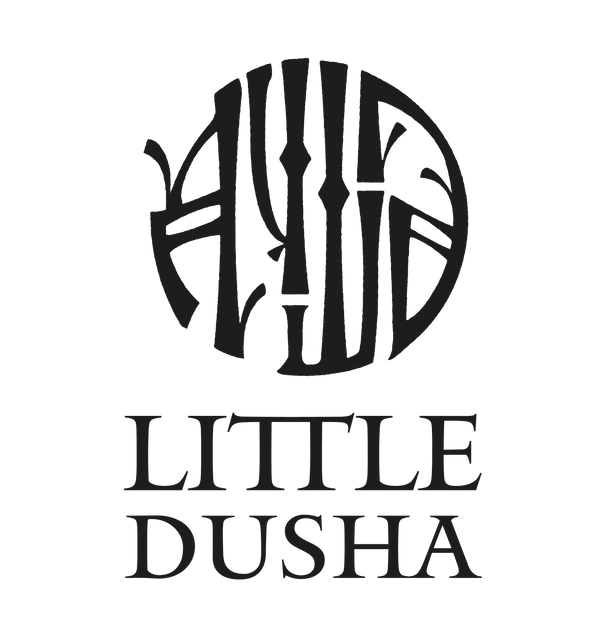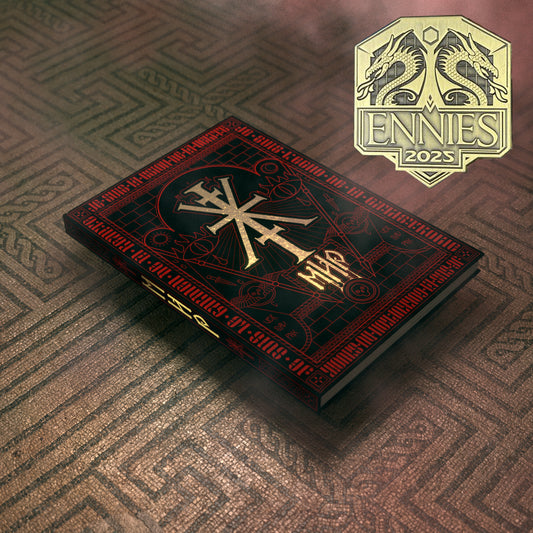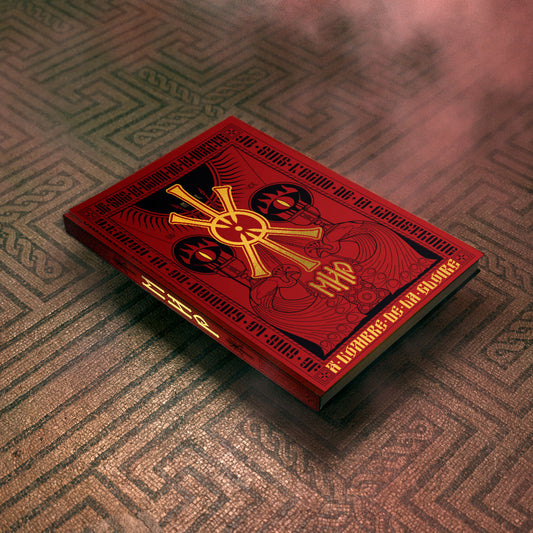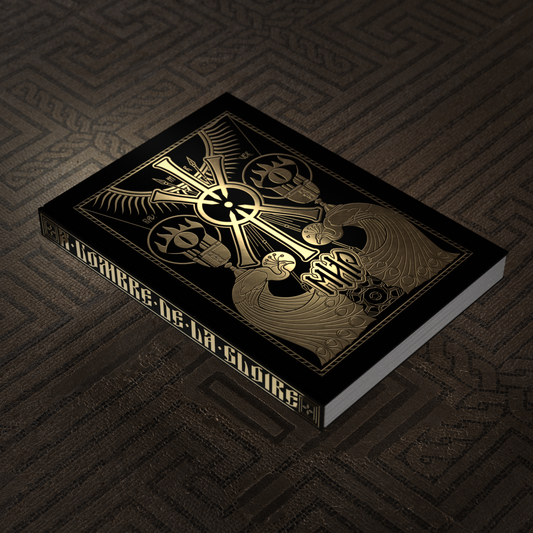This week, we're trading control of Unicity and Vénéatori madness for Anicean honor and love. Far from being a simple formula, this duality impacts their entire gameplay. Ready to take up the gauntlet? Let's go, my friends, death cannot wait!
Who are the Aniceans?
The oldest human state, Anicea is a feudal kingdom whose structure has not changed since its creation. Society is strictly hierarchical and organized around the dead, to whom the living owe respect. In return for their loyalty, the living benefits from the “wisdom” of the ancestors, which is expressed through oracles.
Anicean society is organized around a duality: life and death, love and honor, represented respectively by the Ruddy Moon and the Blue Moon. Once separated into two distinct cults, the two faiths merged after the Ruin to form the cult of the ancestors. Decided at the end of the War of Shame—the Anicean civil war—this union symbolizes the absorption of the cult of Life by that of Death for having supported the rebels. Now, followers of the Ruddy Moon see their beliefs framed by those of the cult of ancestors to avoid any excesses: Life is at the service of Death.
Gameplay
The duality of the Anicéens is reflected in their gameplay, where, depending on the moon to which the player has pledged allegiance, oaths (Honor) or sacrifices (Love) will have more or less effect on their Stigmata, Arts, and style of play. Respecting the creed of your Moon to maximize its effects is tempting, but it also comes with its share of disadvantages. Maintaining a balance between the two concepts will prevent your character from being impacted, but will require you to alternate your devotion.
The Ruddy Moon
Avatar of primordial chaos, the Red Moon demands sacrifices from its worshippers. The greater the life offered to the ancestors, the more manifest their blessings will be. Imbued with its vitality, its worshippers will be more vigorous, lively, and charismatic, but will find it difficult to stay in place, respect conventions, use manipulation, or pay attention to details.
Finally, sacrifices will also bring benefits to the Arts associated with the Ruddy Moon and can make the difference before an important confrontation or a decisive interview. However, animal sacrifices are less powerful than human sacrifices, which are unfortunately prohibited by the laws of the Pact...
The Blue Moon
Avatar of absolute order, the Blue Moon demands trials of its worshippers. The greater the feat accomplished, the more conciliatory the ancestors will be towards the Anicean. Paragons of honor, worshippers of the Blue Moon are inflexible, determined, and relentless, but have difficulty in social relationships, expressing their feelings, or showing initiative.
Passing a trial will strengthen the Arts associated with the Blue Moon and reinforce the bond with the ancestors, a means of gaining their support in future physical and verbal combat. Obviously, the trials are dangerous and require renowned opponents, a challenge commensurate with the rise in power of the Anicean character...
The Stigmata: the judgment of the ancestors
The Setlomnio is a moral code established to control the guilt that has gripped every Anicean since the Ruin. Unlike other human nations governed by rigid laws (Systerins, Iluvetists, Réadarns) or dependent on fragile protection (Vénéatori), the Aniceans enjoy complete freedom.
Undergoing the Stigmata is a matter of choice and therefore of honor. Unless they break their words (break an oath), deny their feelings (refuse to help a relative), or show cowardice (flee from death), Aniceans will never undergo the Stigmata.
Easy for most of the kingdom's inhabitants, respect for this Stigmata is more complex for an Anicéen MIR Agent forced to intrigue to achieve his ends. Joining the organization, a shame for these people willing to do anything to forget the existence of the Ruin (the civil war for the Aniceans), begins with an oath to the MIR.
This is a way of paying the debt owed by the kingdom to the organization, but it is also the only way to ensure the loyalty of an Anicean agent, for whom the interests of the Chapter, and by extension the MIR, rarely coincide with their notion of personal honor. From then on, the Anicean player faces a dilemma: their oath to the MIR or to their ancestors, whose wrath could well awaken their Stigmata.
In conclusion, playing an Anicean means accepting the duality of existence.
Between Life and Death,
Between your Honor and that of the MIR,
Between Love and Honor.
The Enetion - The Forge of Souls
In Anicea, where the past is an obsession, it is customary to wear the rags and bones of one's ancestors over one's clothing to honor them. This macabre aesthetic is the legacy of a nearly lost practice, the sacrifice of the soul, in which the Aniceans sacrificed a part of their body to obtain a bone artifact infused with knowledge.
After the invasion of the kingdom by the Systerin Empire and the massacre of the Cigobens, the production of Enetions declined, and since the Ruin and the “Great War,” only a handful of these relics have been produced.
Wearing a bone artifact is not only a sign of prestige but also proves the value of its wearer, for whom another Anicean sacrificed part of their body, or even their life, to accompany them. Considered the greatest proof of love possible in Anicea, bone artifacts are revered relics whose transmission is the subject of a veritable cult.
The value of these relics can also be explained by their strange property: part of the will of the sacrificed person, greater or lesser depending on the part of the body given, resides within the artifact. The greater the devotion of the sacrificed person, the more consciousness the artifact will have, to the point where some artifacts can move and/or speak. More prosaically, these relics, which are extremely solid, allow the use of the Arts without suffering their interdicts. Thus, Knights can wear a bone helmet and regenerate their flesh without fear of perjury. Needless to say, such objects are extremely valuable and important to the Aniceans, who are capable of mounting military expeditions to obtain them.
GUARDIAN - ANICEAN KNIGHT (possible allegiance to both Moons)
A paragon of honor, the Anicean Knight is the standard-bearer of his civilization. Popularized by the character of Erinos, these glorious warriors ride into the heart of battle, where they can regenerate their flesh thanks to the blood they shed. Exceptional “tanks” (Blue Moon) or accomplished “DPS” (Ruddy Moon), depending on their allegiance, knights are the unyielding pillars of a MIR Chapter... or their gravediggers. Endowed with a special bond with their ancestors, Anicean Knights are assigned additional trials at regular intervals to prove their honor. Refusing to complete them is tantamount to breaking an oath, a choice not to be taken lightly, as the ancestors can deprive the knight of his Arts until he proves his worth again - as with his Stigmata.
Challenging the captain of the guard to a duel, seducing the governor's wife, sacrificing the local lord's only child: the ancestors are not lacking in imagination when it comes to trials, but they are sorely lacking in discernment. These dangerous quests will lead the Chapter into many unforeseen complications - and could well cause its downfall!
The Knight who wins such a trial will be awarded a title related to his feat of arms - “the duelist,” “the seducer,” “the stake” - whose fame will allow him to gain access to new Arts and advantages. Of course, a title must be earned and maintained, so a “duelist” must take up the gauntlet, and a “seducer” cannot ignore a potential conquest.
True to the kingdom's motto - “Love without death is life without merit” - Anicean knights are intended for players seeking moral dilemmas - and excuses to give to the Chapter when trouble arises.
DIPLOMAT - BARD (No allegiances possible)
The emissaries of the kingdom of Anicea are the Bards, a warrior order responsible for maintaining the balance between life and death. As mediators between the two cults, preserving the duality of the kingdom was their sacred mission, and the “Great War” - the Ruin - was the failure of their order.
Outside the caste system, they are the only ones who can interpret the words of the ancestors in public. As one might expect, many Bards are charlatans, but some have preserved the Arts of yesteryear and can pierce the veil with their songs. Messengers between worlds, these oracles use music to bring the will of the ancestors to battle or to court. The laments of the Blue Moon allow them to discern lies and deceit, but also to curse their enemies discreetly, even condemning them to certain death. The songs of the Ruddy Moon purify the mind and bless warriors before and during battle, or, it is said, can bring love where there was only hatred.
However, the intercession of the ancestors comes at a price, as the Bards, guardians of balance, swear an oath of neutrality and their songs, which remove one of the two aspects of reality, must be alternated or they will suffer the Stigmata. Thus, a Song of Life must follow a lament of Death, even if the use of the latter may not be appropriate. A wise Bard saves his music for the right moment, lest he find himself forced to improvise in the wrong circumstances.
A negotiator between worlds, the Bard remains a light fighter trained in a wide variety of weapons, the effects of which can be increased tenfold by his songs: in his hands, a sling can strike as hard as a crossbow and a javelin can fly farther than an arrow!
The Bard is a versatile but demanding class, best suited to players capable of anticipating situations, lest they break their rituals.
ESOTERIST - CIGOBEN (Allegiance to the Blue Moon required)
Priests of the ancestor cult, Cigobens are craftsmen capable of forging the bones of the dead, the final resting place of the soul, to create jewelry, furniture, weapons, or armor. This practice, now almost extinct, remains their privilege, as does the use of the Enetion, the forge of souls. Since the Ruin, Cigobens have become rare and highly sought after: responsible for embalming the dead and performing funeral ceremonies, their order strives to meet the needs of the kingdom. Difficult to recruit, some Cigobens, much to the chagrin of the Aniceans, are nevertheless part of the MIR.
Devoted to the Blue Moon, these agents with their pale complexions and white hair appear frail at first glance: their bodies are thin and lifeless, and their pale pupils often make them appear blind. However, this apparent fragility is deceptive, as the Cigobens are capable of moving at impressive speeds and can withstand blows that would pierce armor without flinching. Their Arts, centered on entropy, allow them to obtain help from their ancestors for a wide variety of tasks ranging from blessings to physical assistance. However, don't make the mistake of confusing a Cigoben with a necromancer, the sworn enemy of the Blue Moon: the priest does not subjugate the dead but is their servant.
In terms of gameplay, the Cigoben is a specialist class with martial abilities that are rare for an Esoterist and capable of creating a multitude of objects for the group - not to mention bone artifacts if he has access to an Enetion. These Arts are versatile, ranging from combat assistance to summoning the dead for clues, but always require personal sacrifice. The more a Cigoben uses his Arts, the stronger the Blue Moon's hold becomes, gradually transforming him into a copy of the ancestors he serves.
Due to its imbalance, this class is best reserved for players who prefer to stay in the shadows, discreet and quiet... At least, with the living!
MAGE - DRUID (Allegiance to the Ruddy Moon required)
Priests of the Ruddy Moon cult, Druids are subject to ancestor worship like the rest of the cult of Life. More numerous than Cigobens, they are also more present within the MIR, even if, like all Aniceans, joining the organization is a source of shame for them. Chaotic and impulsive, Druids are strange mages because they are not specialists per se, but rather jacks of all trades capable of fulfilling almost any role, depending on the sacrifices made.
Druidic sacrifices involve animals and humans (even though this is prohibited by the Pact), whose organs are eaten raw to acquire the characteristics of their bearers. Physical strength, experience, knowledge, and even dreams: everything can be absorbed by a sufficiently experienced Druid. Most Druids carry the organs of their sacrifices with them to consume when the need arises. Thanks to their passive Arts, the digestion of these offal, like that of poisonous mushrooms and other narcotics, seems surprisingly easy.
The Druids' quest for knowledge is all-consuming—literally—and can cause some problems, especially within a MIR Chapter that is supposed to enforce the laws of the Pact. The Aniceans, known for their traditionalism and disdain for the Pact, accept the Druids' cannibalism, but outside the kingdom, it's a different story.
Even without organs attached to their clothing, the Druids' appearance is disturbing: barefoot to be in constant contact with the earth, they wear the skins of sacrificed animals and figures to benefit from their protection. Fortunately, the Druids, blessed by the Ruddy Moon, are charismatic and, according to some, even attractive. The downside of this boundless vitality, aside from a total lack of respect for etiquette, is the Druids' inability to lie—at least in the long run. Indeed, the use of Arts linked to the Red Moon strengthens the symbol's hold over the Druid, changing their personality to make them the avatar of their savage faith.
Like the Cigoben, this class is unbalanced and, while it can fulfill a multitude of roles thanks to its sacrifices and Arts, it should be reserved for players capable of taking on a very polarizing character.
MADLING - WANDERING (possible allegiance to both Moons)
The first Madling revealed to the public, Candara has been emulated on many gaming tables, where players have tested the most “creative” ways to die. Still present despite his countless deaths—a true testament to his tenacity—this character is as fascinating as he is disturbing. Deep down, who is Candara really?
A monster? A victim? A berserker? A repressed patient?
Perhaps a little of everything.
Neither dead nor alive, the Errants are despised by the rest of society and forced to live deep in the forests with the victims of the Setlmonio. Hunted by Anicean knights in search of dangerous adversaries and by the MIR, who want to turn them into agents, the Errants are very rare.
Immortal and invincible, their bodies always end up regenerating, no matter how badly they are destroyed. The only way to destroy the Errants is to cut off each of their limbs and bury them in different locations, far away from each other, at the four cardinal points. Often afflicted by the Stigmata, some Errants nevertheless retain enough presence of mind to be useful to the kingdom. The bravest knights capture them and lock them up like animals to be released before battle, where they are sent to the front lines to occupy the enemy while the army charges.
Some Wanderers, however, manage to control their rage enough to remain in society—that is, if they can hide their repulsive appearance under thick cloth. Unaware of the corruption of the Ruin, due to their curse, the Errants are convinced that they have sinned and seek forgiveness from their ancestors through heroic trials. While some legends speak of Errants who have been forgiven, most remain prisoners of this quest for redemption, gradually succumbing to their destructive rage.
Playing an indestructible character—or almost indestructible—is exhilarating, especially when they can dismember their opponents with their bare hands and rip out hearts left and right (no pun intended). An exceptional fighter, the Errant remains a Madling, meaning an unstable character whose powerful Arts will always impact the rest of their Chapter. Giving him an important role is risky because his rage will get the better of him at some point, and while he cannot be destroyed, it will take too long for a Warlord reduced to ashes to recover to be of any use.
Whether they are idealists seeking redemption or monsters seeking victims on whom to vent their anger, the Wanderer is a character for players who enjoy a challenge. Will they be used by their group, or will they earn their trust through their exploits?
That's all for Anicéa. See you soon for more character creation news!




